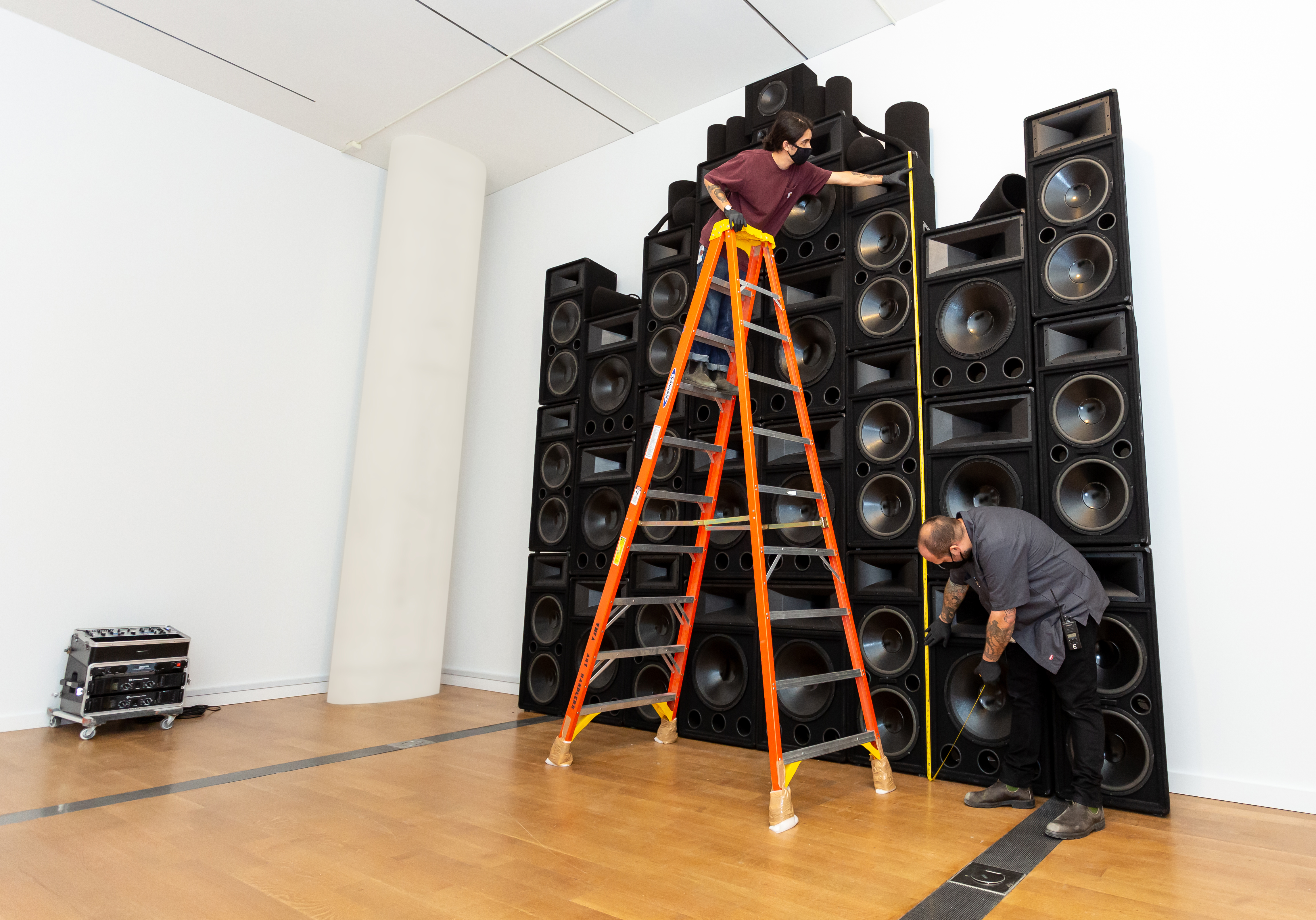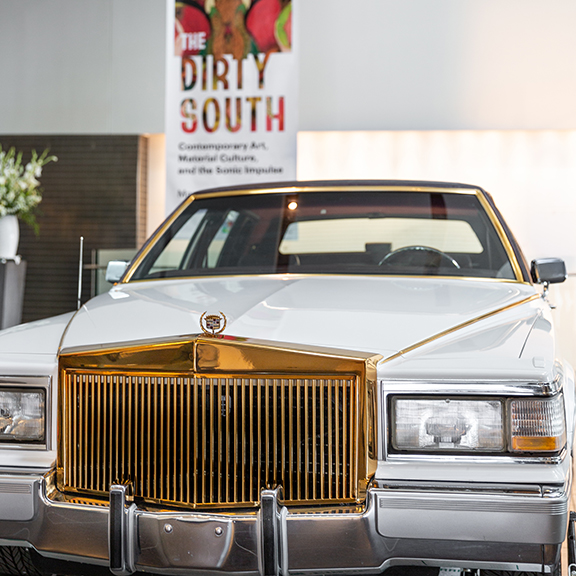When the public experiences an exhibition at the Virginia Museum of Fine Arts, they see not only the art on view but also the culmination of years of work by teams of museum professionals who take a curator-led journey from conception to realization. While an exhibition’s star attractions are the works of art on view, oftentimes the curator becomes a star in their own right.
One such star is Valerie Cassel Oliver, VMFA’s Sydney and Frances Lewis Family Curator of Modern and Contemporary Art, whose scholarship and planning for The Dirty South: Contemporary Art, Material Culture, and the Sonic Impulse have been years in the making. Her curatorial endeavors at VMFA have greatly expanded the museum’s storytelling with acclaimed exhibitions such as Howardena Pindell: What Remains To Be Seen, Cosmologies from the Tree of Life: Art from the African American South, and now The Dirty South. She has also multiplied the number of African American works of art in the museum’s permanent collection to include Kehinde Wiley’s Rumors of War and many other celebrated acquisitions.
Here, in a Q&A between Cassel Oliver and Jan Hatchette, VMFA’s Deputy Director for Communications, the two colleagues, who are also friends, take you behind the scenes to learn how The Dirty South: Contemporary Art, Material Culture, and the Sonic Impulse came to be.
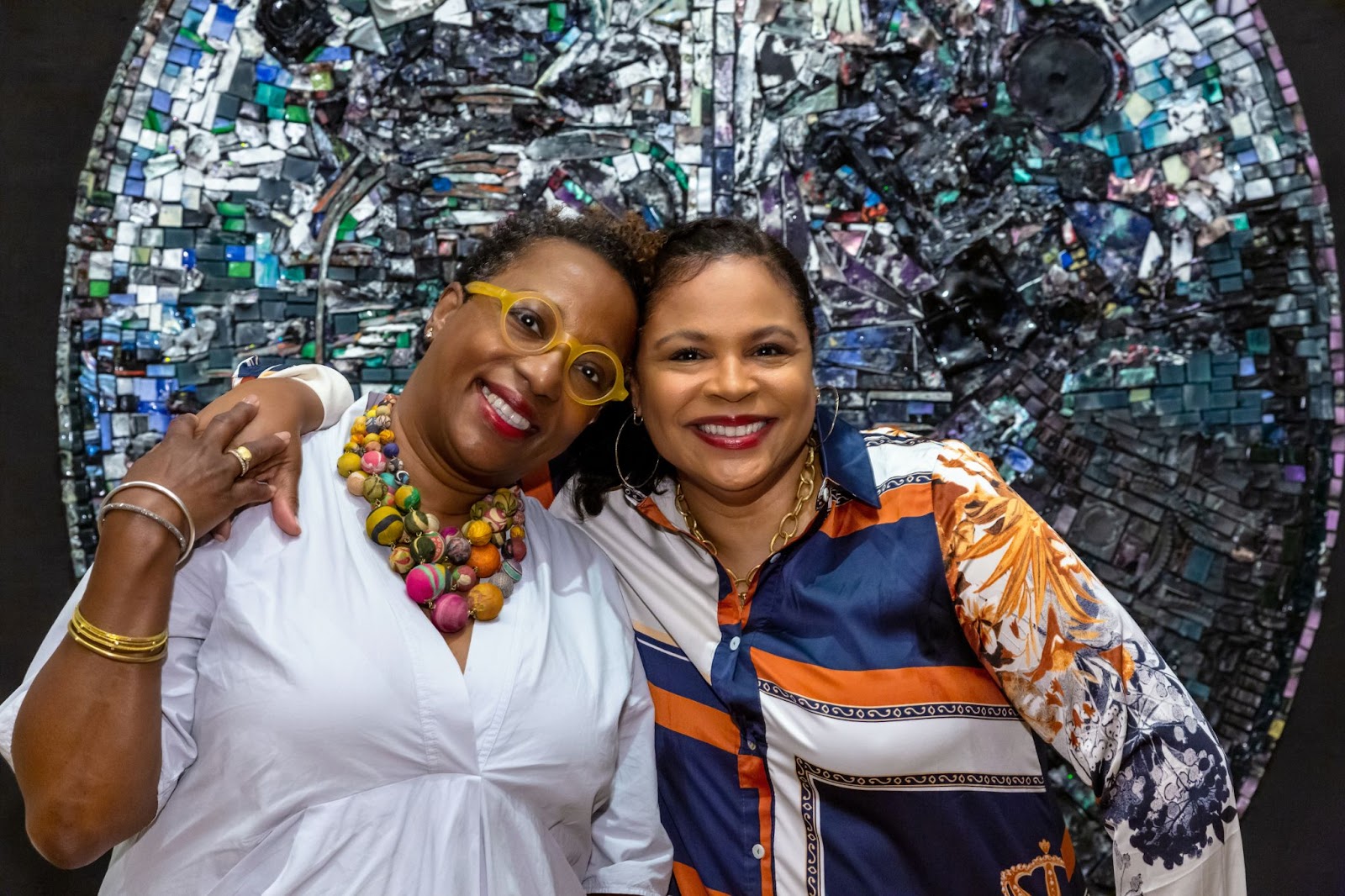
Valerie Cassel Oliver (left) and Jan Hatchette (right). Photo by Sandra Sellars ⓒ Virginia Museum of Fine Arts
Hatchette: You’ve mentioned that the exhibition is your love song to the South. You’re a southerner who grew up in Houston, Texas, and spent several years of your professional life there as well. Can you share any personal reflections on the meaning of the “Dirty South” in terms of your own familial, creative, cultural roots?
Cassel Oliver: Absolutely. I will say yes, indeed, this is a love song. It has been a labor of love. I think more than any other exhibition, The Dirty South has allowed me to bring to bear a holistic approach . . . directed by my upbringing and my professional experience. I embraced this notion of the culture from which I emerged in terms of how we think, speak, and create. It was as much about linking those who are not academically trained . . . what I consider our creative intellectuals, our folk artists to those artists who have been taught by the academy and then bringing into that conversation, sound. Sound as music, sound as material . . . it was about melding that sound and allowing it also to be in dialogue with visual artists. That’s the notion of the sonic impulse.
But getting to this whole concept of the Dirty South, I think the way I always experienced it as a child was through any understanding that the South was an agrarian society—a society built from the earth and all the history that entails. I also understood it as a mixture . . . the fact that the South is an amalgamation of things, that there is this sense of the collision of cultures that give a rise to who we are as African Americans. We are no longer the Africans who came forcibly enslaved, Black culture is born out of that fragmentation and the absorption of other cultures. There is a complexity to Blackness. It’s not this flat, monolithic construct . . . we are born from a very complex web of histories, experiences, and encounters. All this works to give rise to the African American South.
Hatchette: When and how did you first begin to formulate in your mind the “Dirty South” as an art history narrative that you wanted to investigate?
Cassel Oliver: Well, it started in Houston when I was still senior curator with the Contemporary Arts Museum Houston. I began exploring the work of a younger generation of artists who were very much aware of the music scene and, because of it, were embracing their southerness with a new sense of pride. Something about the music gave them a sense of pride of being from the South. When I meditated upon this . . . it dawned upon me that up until that moment, we are framing the African American existence in the South from a vantage point of as survivors . . . survivors to the trauma of enslavement, Jim Crow, Massive Resistance, and everything that comes in the aftermath. The civil rights movement was born of struggle . . . blood, sweat and tears. The weight of that still hung in the air. Those African Americans who left or migrated outward from the South somehow felt more sophisticated than those who stayed. There were better opportunities for education and economic mobility. And while that was true, there was also growth and sophistication happening in the South. And yet, there was no way to really frame or present that, especially amid the backdrop of struggle.
However, in the mid-1990s, there is a shift, and it is most palpable through the music. Outkast, Goodie Mob, DJ Screw, Getto Boyz, No Limit Records . . . emerge with a sense of pride in being southern.
Hatchette: We both joined VMFA in 2017, after the museum had already begun to intensify its efforts to showcase more inclusive exhibitions. When you first arrived, did you already have plans to curate The Dirty South exhibition? If so, can you tell me about how this exhibition fit in with plans VMFA already had underway?
Cassel Oliver: Yes, absolutely. So, I came to VMFA with two projects. One was the Howardena Pindell project. And the second was the Dirty South. It changed and shifted because I went from a non-collecting contemporary art museum into an encyclopedic museum. It made sense to elongate the conversation and connect it historically. So instead of framing it only within the late 20th and early 21st century, there was an ability to show the trajectory of dialogue between visual art genres and across disciplines. I could really dig into where that conversation between the production of our objects and the production of sound and music have intersected over time. There is a real luxury of looking through the museum’s holdings to draw into the same space a long history of Black creative brilliance. That really allowed me to think much broader. And so, while the seeds were planted in Houston, the contour of this exhibition is really developed here.
Hatchette: There must have been many exciting developments over the years, as you worked toward the opening of The Dirty South. Is there any one moment in your research or planning that stands out in your mind as being a particularly thrilling indicator of how the exhibition was coming together?
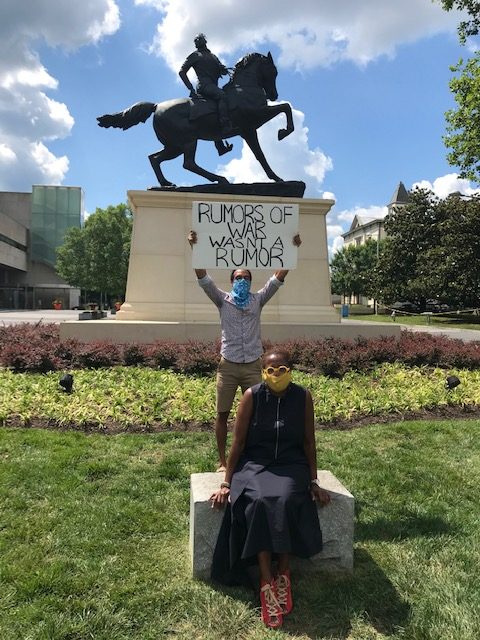
Valerie Cassel Oliver (seated) with Clifford Chambliss III, the artist whose 2020 protest sign garnered international attention for its reference to Kehinde Wiley’s Rumors of War, which was added to VMFA’s collection in 2019 under Cassel Oliver’s curatorship. Photo by David Stover
ⓒ Virginia Museum of Fine Arts
Cassel Oliver: Well, not one moment, but many moments. I think 2020 has to be seen as a time when two pandemics emerge and shake us to our core. Of course, there is COVID-19 and then there is the issue of racism in this country and how it has manifested time and time again in the sanctioned violence against Black bodies. And so what you do see is the culmination of that, unfortunately with the death of George Floyd in the most stark and unfiltered way. And then there was a political and social weariness/anxiety that just hung in the air. The confluence of it all—the rawness and callousness of the moment necessitated a response. I think the event and all that preceded it shook this country and communities around the world. The profound injustice simply reverberated. And art has a role to play in how we see and process the chaos. Art can be a balm for the soul; a spear of awareness; and/or a blunt instrument of resistance. It has the capacity and power. Art and art-making does not happen in a vacuum. It is a product of its time and the moment. So, none of the artwork in this exhibition happened in a vacuum. My practice as a curator does not happen in a vacuum. That doesn’t make it political . . . it does however underscore the desire to help the “communal us” understand the current and historical moment and how they are linked. What was very interesting to me is to see over the course of time how artists have been chronicling these histories of sanctioned violence against Black bodies—whether that is how artists use the material, the language, and the music of “Strange Fruit,” which was written as a song to bring awareness about lynching in the South, to how we really see our bodies existing in the current landscape. Whether that’s Mel Chin’s Night Rap, which is a baton with a microphone on the end of it, there are so many things that have transpired that we can trace these things. We can trace them through the visual rendering that artists give to us. We can trace them through the lyrics in the songs that have been written about it. And I think that gave a different kind of weight to this exhibition, a different kind of viewpoint and perspective. And that’s not to say that we sit in trauma as a Black community. We do not, but we understand it. We resist trauma and in spite of it, we create and retain this sense of hope and the sense of joy. And so that also comes through this exhibition. So I think those things really helped shape the outline and context. It is present through the visible work and in the words of the contributors to the accompanying catalogue. All in all, this exhibition offers visitors a different kind of lens through which they can see, understand and appreciate the journey thus far. The works are visually arresting, but they are also deeply emotive in their exchange and call and response across time. It is very elucidating and emotive. And, I feel the totality of the experience reverberates because of that.
Hatchette: I’ve walked through the exhibition probably 10 times now, and I’m inspired by so much. I know you don’t have any personal favorites, but are there works that speak to you personally?
Cassel Oliver: There are so many favorites . . . this is the issue! Again, I feel the works are as visually powerful as they are emotionally riveting. There is a collective power. The emotive power is palpable. You can feel it. You see it and you feel it. The works are all the more powerful because of the dialogue . . . so, it’s hard to choose a favorite. There are many works that speak to me. . . .
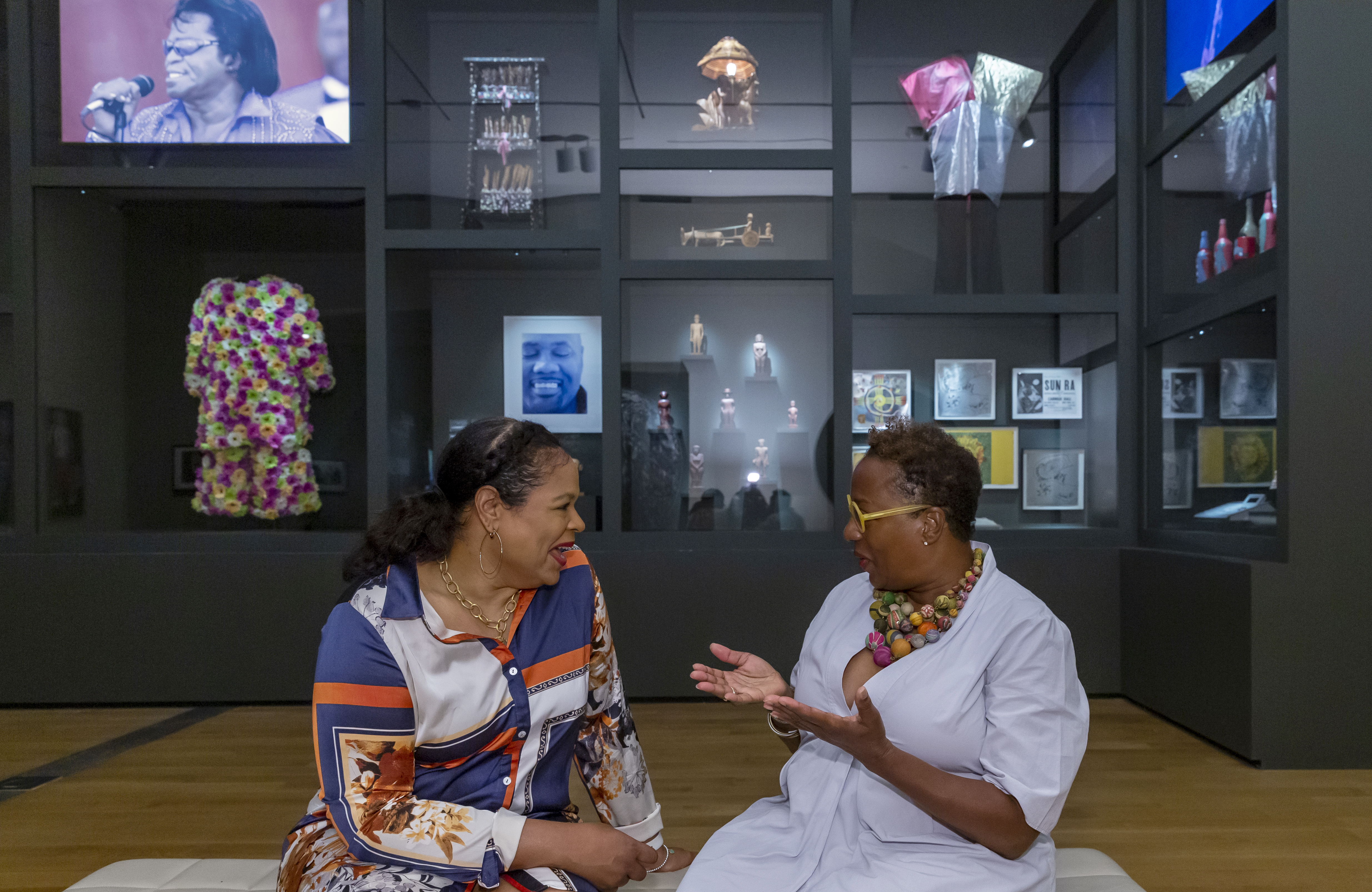
Valerie Cassel Oliver (right) and Jan Hatchette (left) seated before the exhibition’s “Cabinet of Wonders.” Photo by Sandra Sellars ⓒ Virginia Museum of Fine Arts
Hatchette: What have you found most rewarding about the storytelling aspect of your work—on this exhibition and curatorial work in general?
Cassel Oliver: I think it is about expanding the canon to be more inclusive. There is a lot of synergy between the mission of the museum and my practice as a curator. It has always been my intention to expand the canon . . . to include voices that often are not included, particularly Black voices. That said, I am also deeply invested in expanding the narrative to include all voices. Museums, as institutions, have to function for everyone. Support for museums should be democratized . . . and to a degree it is, but it is about creating reciprocity. People will feel an ownership if they can recognize themselves—specifically or universally. I think that is a big part of it, and I feel that VMFA is very committed to that. And it makes the job that I do so much easier.

